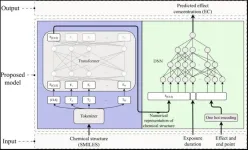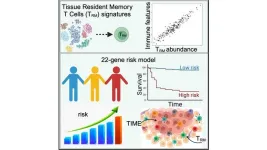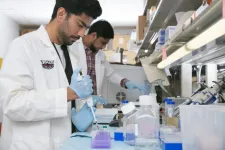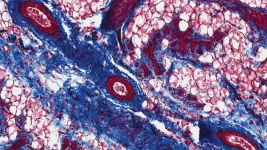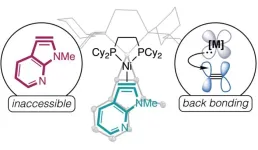(Press-News.org) Swedish researchers at Chalmers University of Technology and the University of Gothenburg have developed an AI method that improves the identification of toxic chemicals – based solely on knowledge of the molecular structure. The method can contribute to better control and understanding of the ever-growing number of chemicals used in society, and can also help reduce the amount of animal tests.
The use of chemicals in society is extensive, and they occur in everything from household products to industrial processes. Many chemicals reach our waterways and ecosystems, where they may cause negative effects on humans and other organisms. One example is PFAS, a group of problematic substances which has recently been found in concerning concentrations in both groundwater and drinking water. It has been used, for example, in firefighting foam and in many consumer products.
Negative effects for humans and the environment arise despite extensive chemical regulations, that often require time-consuming animal testing to demonstrate when chemicals can be considered as safe. In the EU alone, more than two million animals are used annually to comply with various regulations. At the same time, new chemicals are developed at a rapid pace, and it is a major challenge to determine which of these that need to be restricted due to their toxicity to humans or the environment.
Valuable help in the development of chemicals
The new method developed by the Swedish researchers utilises artificial intelligence for rapid and cost-effective assessment of chemical toxicity. It can therefore be used to identify toxic substances at an early phase and help reduce the need for animal testing.
"Our method is able to predict whether a substance is toxic or not based on its chemical structure. It has been developed and refined by analysing large datasets from laboratory tests performed in the past. The method has thereby been trained to make accurate assessments for previously untested chemicals," says Mikael Gustavsson, researcher at the Department of Mathematical Sciences at Chalmers University of Technology, and at the Department of Biology and Environmental Sciences at the University of Gothenburg.
"There are currently more than 100,000 chemicals on the market, but only a small part of these have a well-described toxicity towards humans or the environment. To assess the toxicity of all these chemicals using conventional methods, including animal testing, is not practically possible. Here, we see that our method can offer a new alternative," says Erik Kristiansson, professor at the Department of Mathematical Sciences at Chalmers and at the University of Gothenburg.
The researchers believe that the method can be very useful within environmental research, as well as for authorities and companies that use or develop new chemicals. They have therefore made it open and publicly available.
Broader and more accurate than today's computational tools
Computational tools for finding toxic chemicals already exist, but so far, they have had too narrow applicability domains or too low accuracy to replace laboratory tests to any greater extent. In the researchers' study, they compared their method with three other, commonly used, computational tools, and found that the new method has both a higher accuracy and that it is more generally applicable.
"The type of AI we use is based on advanced deep learning methods," says Erik Kristiansson. "Our results show that AI-based methods are already on par with conventional computational approaches, and as the amount of available data continues to increase, we expect AI methods to improve further. Thus, we believe that AI has the potential to markedly improve computational assessment of chemical toxicity.”
The researchers predict that AI systems will be able to replace laboratory tests to an increasingly greater extent.
"This would mean that the number of animal experiments could be reduced, as well as the economic costs when developing new chemicals. The possibility to rapidly prescreen large and diverse bodies of data can therefore aid the development of new and safer chemicals and help find substitutes for toxic substances that are currently in use. We thus believe that AI-based methods will help reduce the negative impacts of chemical pollution on humans and on ecosystem services," says Erik Kristiansson.
More about: the new AI method
The method is based on transformers, an AI model for deep learning that was originally developed for language processing. Chat GPT – whose abbreviation means Generative Pretrained Transformer – is one example of the applications.
The model has recently also proved highly efficient at capturing information from chemical structures. Transformers can identify properties in the structure of molecules that cause toxicity, in a more sophisticated way than has been previously possible.
Using this information, the toxicity of the molecule can then be predicted by a deep neural network. Neural networks and transformers belong to the type of AI that continuously improves itself by using training data – in this case, large amounts of data from previous laboratory tests of the effects of thousands of different chemicals on various animals and plants.
More about: the research
The study, Transformers enable accurate prediction of acute and chronic chemical toxicity in aquatic organisms, has been published in Science Advances. It was carried out by Mikael Gustavsson and Erik Kristiansson at Chalmers University of Technology and the University of Gothenburg, Styrbjörn Käll, Juan S. Inda-Diaz, and Sverker Molander at Chalmers University of Technology, and Patrik Svedberg, Jessica Coria and Thomas Backhaus at the University of Gothenburg.
END
Toxic chemicals can be detected with new AI method
2024-05-02
ELSE PRESS RELEASES FROM THIS DATE:
The people who are most active on social media are also the most active offline
2024-05-02
Parents often worry about the use of social media among children and young people. Caring about this is a good thing, and there are several reasons why you should pay attention, but there is one thing that parents needn’t worry about: young people spending time on social media does not impair their interaction with friends offline, according to a new study.
“On the contrary, we find that people who use social media a lot spend more time with friends offline,” says Professor Silje Steinsbekk at the Norwegian University of Science and Technology (NTNU’s) Department of Psychology.
The results are ...
Climate is one culprit in spread and growth of dust in Middle East
2024-05-02
Climate change is transforming dust storms—a natural phenomenon in the Middle East—into a more frequent and widespread threat to health and economies throughout the region, a new study shows.
Dust levels have increased in many parts of the Middle East chiefly due to global warming, but other human activities also share credit, says Zahra Kalantari, associate professor at KTH Royal Institute of Technology. She cites such factors as oil extraction, military conflicts and lack of cross-border ...
Gene signatures from tissue-resident T cells as a predictive tool for melanoma patients
2024-05-02
(LOS ANGELES) – May 2, 2024 - An extensive analytical study conducted at the Terasaki Institute for Biomedical Innovation (TIBI) has revealed an association between favorable survival outcomes for melanoma patients and the presence of higher populations of tissue-resident memory T cells (TRM). Data obtained from this study could be used not only for a TRM-based machine learning model with predictive powers for melanoma prognosis but could also elucidate the role TRM cells can play in the tumor immune microenvironment. This could guide the development of more effective and personalized anti-tumor immunotherapeutic treatment regimens for cancer ...
FAU creates new Department of Biomedical Engineering
2024-05-02
In recognition of a rapidly growing field, Florida Atlantic University’s College of Engineering and Computer Science (COECS) has created a Department of Biomedical Engineering. The newly established department will focus on three key areas: biomaterials and tissue engineering; smart health systems; and bio-robotics. Biomedical engineering integrates fundamental and practical concepts in electrical and mechanical engineering, biology, computer science and medicine into a cross-disciplinary field focused on improving human health and solving problems in the delivery of health care.
The COECS faculty are already performing ...
Program announced for NUTRITION 2024 to be held June 29–July 2
2024-05-02
Reporters are invited to join leading nutrition researchers and professionals at NUTRITION 2024, the annual flagship meeting of the American Society for Nutrition. The meeting will bring together thousands of experts from around the globe to share and discuss emerging scientific and policy developments in food, nutrition and public health June 29–July 2 in Chicago.
The meeting program features exciting scientific symposia, award lectures, networking events and more, offering an up-close view into the latest findings, opportunities and debates. More than 1,600 original research studies will be presented ...
A link between breast changes and … UTIs?
2024-05-02
Women’s health is often talked about in terms of major, life-altering events like pregnancy and menopause. A new study from Cold Spring Harbor Laboratory (CSHL) underscores the importance of considering everyday occurrences’ impact on women’s well-being.
CSHL researchers have made a surprising discovery involving urinary tract infections (UTIs). The scientists found that UTIs in mice can provoke a bodily response that results in structural changes in breast tissue. Remarkably, these changes are reversible ...
Researchers create new chemical compound to solve 120-year-old problem
2024-05-02
MINNEAPOLIS/ST. PAUL (05/02/2024) — For the first time, chemists in the University of Minnesota Twin Cities College of Science and Engineering have created a highly reactive chemical compound that has eluded scientists for more than 120 years. The discovery could lead to new drug treatments, safer agricultural products, and better electronics.
For decades, researchers have been investigating molecules called N-heteroarenes, which are ring-shaped chemical compounds that contain one or more nitrogen atoms. Bio-active molecules having a N-heteroarene core are widely ...
Four state-of-the-art, artificial intelligence search engines for histopathology images may not be ready for clinical use
2024-05-02
Four proposed state-of-the art image search engines for automating search and retrieval of digital histopathology slides were found to be of inadequate performance for routine clinical care, new research suggests.
The performance of the artificial intelligence algorithms to power the histopathology image databases was worse than expected, with some having less than 50% accuracy, which is not suitable for clinical practice, said Dr. Helen Shang, a third-year internal medicine resident and incoming hematology-oncology fellow at the David Geffen School ...
Young adults reduced drinking during and after pandemic
2024-05-02
A new study examined the drinking levels and patterns of young adults before, during and after the pandemic. The researchers found alcohol use and alcohol-related problems substantially decreased in heavy-drinking young adults during the pandemic, and these decreases were still evident as the pandemic began to wane. The results are available in the May 2 issue of the journal Nature Mental Health.
“The pandemic gave us a unique opportunity to see how wide-spread mitigation measures like social distancing and bar/restaurant closures may have affected alcohol consumption,” said lead ...
Random robots are more reliable
2024-05-02
Northwestern University engineers have developed a new artificial intelligence (AI) algorithm designed specifically for smart robotics. By helping robots rapidly and reliably learn complex skills, the new method could significantly improve the practicality — and safety — of robots for a range of applications, including self-driving cars, delivery drones, household assistants and automation.
Called Maximum Diffusion Reinforcement Learning (MaxDiff RL), the algorithm’s success lies in its ability to encourage robots to explore their environments as randomly as possible in order to gain a diverse set of ...
